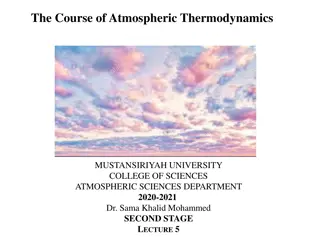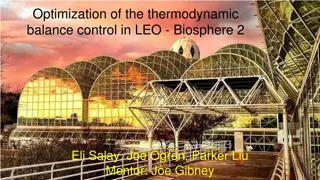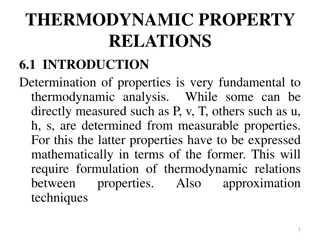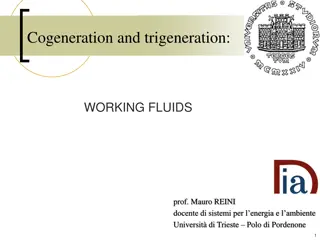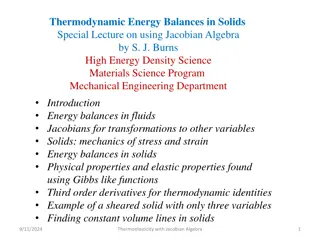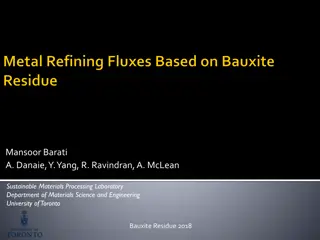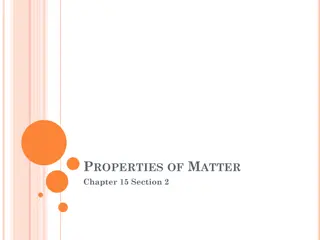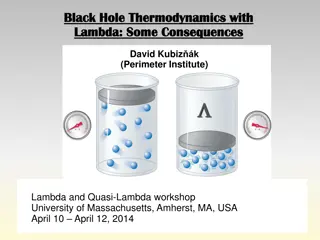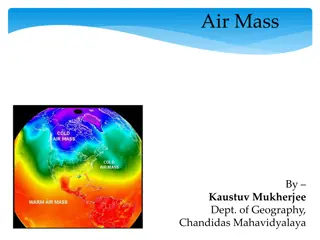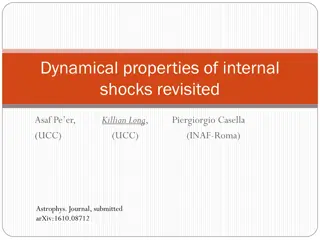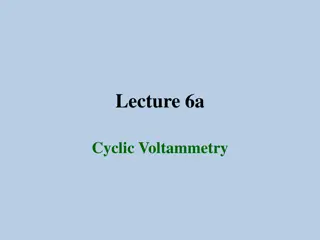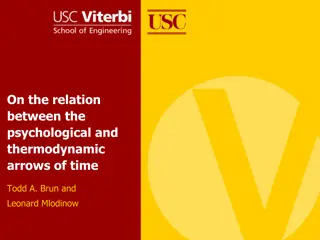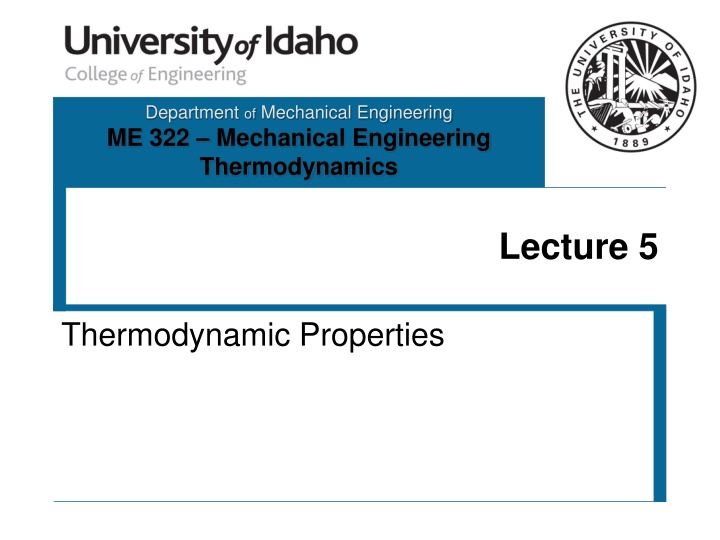
Thermodynamic Properties and Behavior of Substances
Explore the importance of studying thermodynamic properties, phases of matter, and the behavior of pure substances like water in thermodynamics. Learn about key concepts such as state, property, process, and their interrelations in energy conversion systems.
Uploaded on | 1 Views
Download Presentation

Please find below an Image/Link to download the presentation.
The content on the website is provided AS IS for your information and personal use only. It may not be sold, licensed, or shared on other websites without obtaining consent from the author. If you encounter any issues during the download, it is possible that the publisher has removed the file from their server.
You are allowed to download the files provided on this website for personal or commercial use, subject to the condition that they are used lawfully. All files are the property of their respective owners.
The content on the website is provided AS IS for your information and personal use only. It may not be sold, licensed, or shared on other websites without obtaining consent from the author.
E N D
Presentation Transcript
Department of Mechanical Engineering ME 322 Mechanical Engineering Thermodynamics Lecture 5 Thermodynamic Properties
Why Study Properties of Substances? In thermal systems, the goal is energy conversion. A working fluid usually transports the energy from one component to another. In order to analyze and design the components of this system, the properties of the working fluid need to be known. 2 2
Thermodynamic Properties We have referred to the following properties several times p=Pressure T =Temperature =Density We have also previously introduced the specific volume, 1 V m = = = specific volume v For a single phase pure substance, the State Postulate says that the thermodynamic state can be fixed by two independent intensive properties. 3
Thermodynamic Vocabulary What is a State? (give an example) What are the phases of matter? What is a Property? (give an example) What is a Process? (give an example) How are each of these related? How are each of these unique? 4
P-v-T Behavior of Pure Substances Substance that expands upon freezing (water) Substance that contracts upon freezing (everything else) 5
Thermodynamic Properties Using the chain rule from calculus, we can write v p v T ( ) = = + , v v p T dv dp dT p T In mathematical expansions like this, the partial derivatives are often properties or related to properties. For example, 1 v v T isobaric coefficient of volume expansion = = p 1 v v p = = isothermal coefficient of compressibility T dv v = dT dp 6
and for Various Substances In most engineering tables, the scientific notation in the column heading implies that the number in the table had to be multiplied by 10n to be recorded in the table as shown. Therefore, the value of for benzene from Table 3.2 is, = = 6 0.689 10 1/R 1.24 10 1/K 6 Notice the sign in the exponent of 10 7
Significance Using the chain rule and introducing and , we found, dv v = dT dp This equation can be integrated between any two states to determine the volume change of a substance! This equation allows us to determine the volume change of a substance as it undergoes changes in its thermodynamic state from p1,T1 to p2,T2. Study Example 3.2 in your textbook! 8
Using and *If* you assume that and are constant over the temperature and pressure range (usually an okay assumption if you aren t near a phase change), then the equation below can be integrated dv v = dT dp .and it will become ln?2 = ? ?2 ?1 ? ?2 ?1 ?1 We can use this to find changes in specific volume due to changes in temperature and pressure 9
Visualizing (isobaric coefficient of volume expansion) At a constant pressure (horizontal on p-T diagram), how does specific volume change as temperature changes? i.e. what is the change in v due to the change in T? 1 v 1 v v T v p = = p T 10
Visualizing (isothermal coefficient of compressibility) At a constant temperature (vertical on a p-T diagram), how does specific volume change as pressure changes? i.e. what is the change in v due to the change in P? 1 v 1 v v T v p = = p T 11
Why is P-v-T Behavior Important? ( ) = , p p v T Equation of State All thermodynamic properties can be determined from the equation of state. They are hidden and need to be extracted with mathematics. For example 1 v 1 v v T v p = = p T 12
Example Consider the Ideal Gas Equation of State (EOS) = pv RT 1 v v T = Let s find an expression for for an ideal gas. p RT p v T R p = = v p 1 v 1 v 1 T v T R p p R p = = = = RT p We just discovered that the isobaric coefficient of volume expansion for a substance that can be modeled as an ideal gas is 1/T ! A related derivation for kappa is on the website. 13
Properties from P-v-T Behavior Research in the University of Idaho Center for Applied Thermodynamic Studies (CATS) Mathematical model based on experimental data Results published in high-quality scientific journals Applications Experimental data Computer Software There s an app for that! Tables & Charts in Books 14
Internal Energy V V z = 35,000 ft above sea level To an observer on the ground, the water in the glass has a total energy content made up of, = + + E U KE PE U = the internal energy of the water. This is the energy resulting from molecular motion (translation, vibration, rotation, etc.) consistent with its thermodynamic state (e.g. quantified by its temperature and pressure). 15
Internal Energy The total energy (extensive form) of any system is given by, = + + E U KE PE U, KE, and PE are all properties of the system. The specific energy (intensive form) of any system is given by, E m U m KE m PE m = = + + = + + e e u ke pe u, ke, and pe are all specific properties of the system. Question to think about: I know how to find ke and pe. But how can I find u? 16
Isochoric Specific Heat For a single phase pure substance, u can be specified by any two independent intensive properties. Therefore consider, u T u v ( ) = = + , u u T v du dT dv v T The isochoric specific heat is defined as, u T = c v v u v ( ) = = + , u u T v du c dT dv Therefore, v T 17
Enthalpy and Isobaric Specific Heat A convenient grouping of other properties = + = + H U pV h u pv Specific enthalpy Total enthalpy h T h p ( ) = = + , h h T p dh dT dp p T The isobaric specific heat is defined as, h T = c p p h p ( ) = = + , h h T p dh c dT dp Therefore, p T 18



